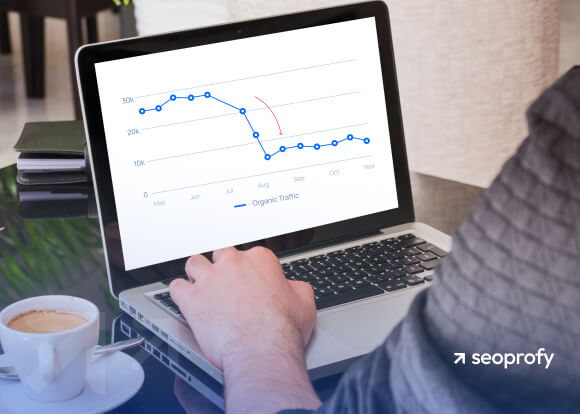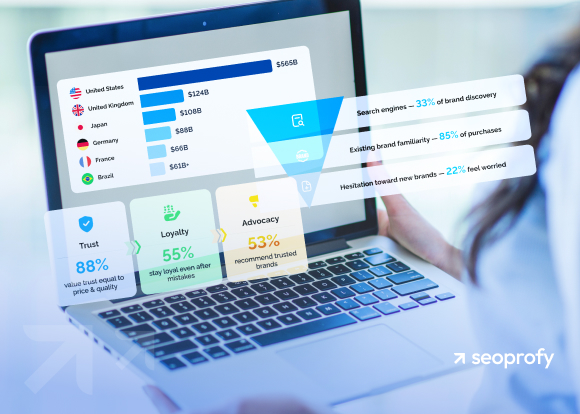Has your organic traffic dropped suddenly? It could be due to a Google update, technical issues, or simply a change in search behavior. Whatever the reason is, there are ways to fix that, and we’re going to explore them today.
Fortunately, you’re not alone. You’d probably find “how to fix drop in organic traffic” to be among the most popular search queries every time Google does an update. As to why your Google ranking dropped, well, it’s a complex web of factors — from search engines releasing updates to poor site migration.
The key here is to stay calm and follow a structured approach. If you see the issue on your site, as shown below, then you are in the right place. We’ll help you identify exactly what’s causing the decline and go over troubleshooting tips, along with other professional solutions, to help you recover as fast as possible.

Common Issues of a Sudden Drop in Organic Traffic
Wondering, “why did my organic traffic drop?” There are many reasons as to why your rankings tanked, each with varying degrees of complexity especially when you’re trying to recover from them. However, it often boils down to eight primary reasons:
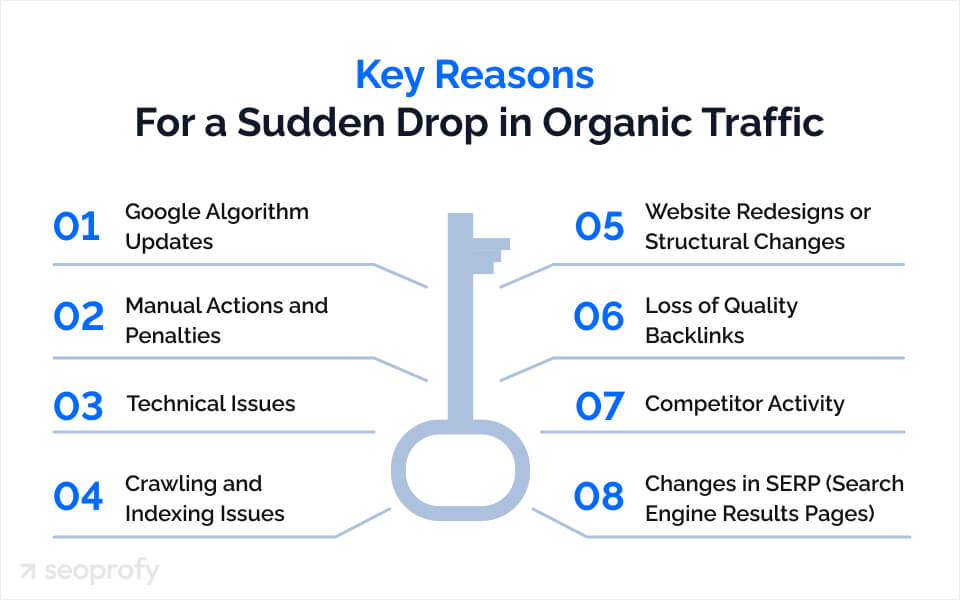
- Google algorithm updates
- Manual actions and penalties
- Technical issues
- Crawling and indexing issues
- Website redesigns or structural changes
- Loss of quality backlinks
- Competitor activity
- Changes in SERP
Google Algorithm Updates
To troubleshoot sudden traffic drops, the first step is to examine recent Google updates. Many SEO-related issues and disruptions are caused by them. If you’ve been following Google’s updates since 2023, you should be familiar with how frequently it updates its algorithms, especially with regard to AI.

Google changes its algorithms for a variety of reasons, but the end goal is to improve the quality of search results. The problem is that these changes can sometimes cause a sudden drop in referral traffic for websites that don’t meet new criteria.
If your site is losing links or suffering from unreliable data, you need to act fast. A sudden drop in traffic can happen due to broken tracking code, inbound links vanishing, or technical issues. You can uncover these issues and take control by using Google Search Console (GSC) and Google Analytics. We’ve outlined the steps we took to restore traffic after the 2023 Google update in our latest case study.
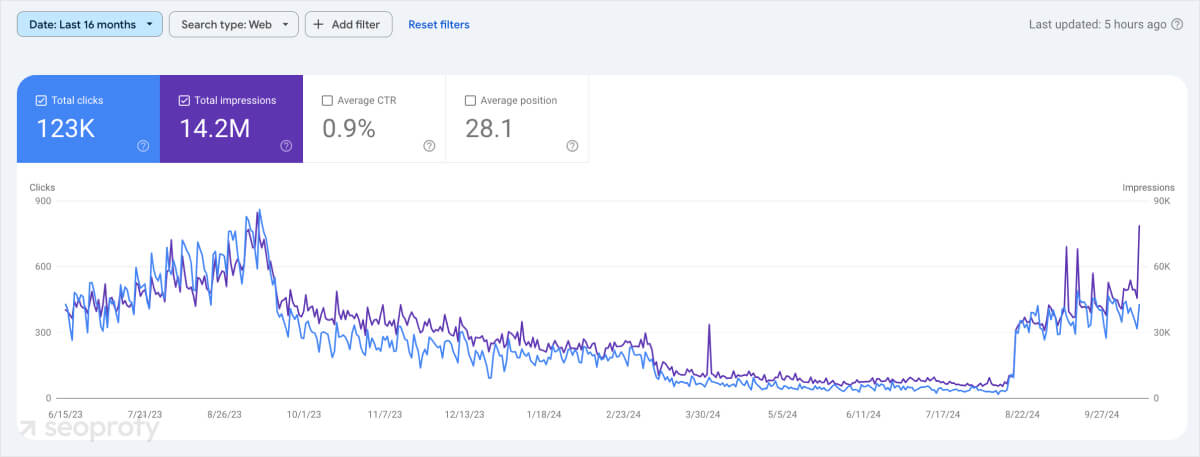
Let us help you recover from traffic loss with a tailored strategy. Book a consultation today and enjoy these benefits:
- Restored search rankings
- More visitors with improved visibility
- Enhanced performance for mobile devices

Manual Actions and Penalties
If your traffic drop wasn’t caused by a Google Core Update, it’s possible your search rankings or SERP visibility plummeted because of a Google manual action.
Your website may be penalized if a human reviewer determines that it violates Google’s guidelines. These penalties are typically handed out for practices like keyword stuffing, cloaking, or using paid backlinks. Here’s how you can check if you’ve been penalized:
- Log in to GSC with your Google account.
- Choose the website property you want to check.
- In the dashboard’s left-side menu, you will find the “Security & Manual Action” section. There, Google lists any penalties that may have been applied to your site.
- If there are any manual actions against your site, you will see a count at the top of the report.
- Review them carefully. You’ll find detailed information about each.

The good news is that most manual actions can be resolved. You’ll need to make the necessary fixes and then request a review from Google.
How can you prevent a Google Manual Action penalty? The key is to avoid it from the outset by following Google’s Search Essentials. Create high-quality, original content and avoid any black hat SEO techniques that could get you in trouble.
Technical Issues
Addressing sudden traffic loss may require a closer examination of your site to make sure it is not the cause of a significant decline in rankings or engagement. If on-page SEO optimization cannot resolve your organic traffic drops, it might be time to do a site audit to identify and fix technical SEO issues, such as:
- Slow site speed
- Broken links
- Improper redirects
- Site redesign
- Poor mobile usability
A slow-loading website is always a frustrating experience. This increases your bounce rate, which signals to Google that your site isn’t providing a good user experience. In turn, this can lead to lower rankings and a sudden organic traffic drop. Tools like Google’s PageSpeed Insights can help you identify speed issues, while Google Search Console can alert you to indexing problems or crawl errors.
Crawling and Indexing Issues
One of the most commonly overlooked SEO mistakes causing traffic drop is if your site isn’t crawlable. If Google can’t crawl or index your site properly, it’s like trying to find a book in a library that hasn’t been cataloged.
Your pages won’t show up in search results, which causes a major traffic decrease. Common organic traffic loss reasons related to crawling include a poorly configured robots.txt file, bad site structure, or broken internal links. Find the root cause by heading to GSC and checking the Coverage Report. This will tell you if there are any pages that Google isn’t indexing, along with the reasons why.
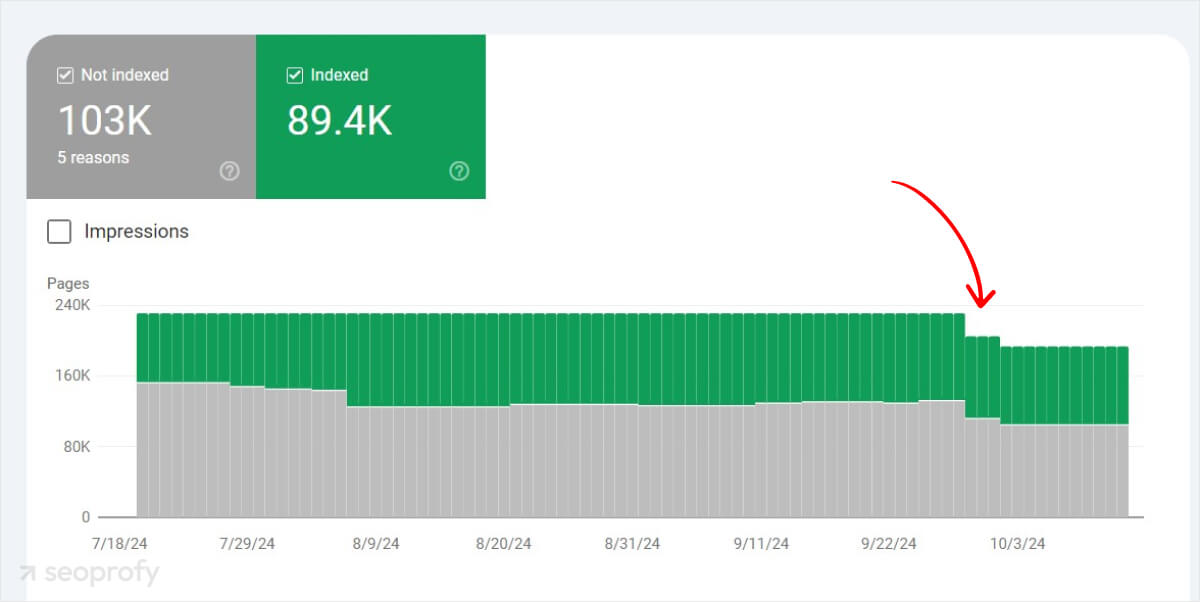
Sometimes, it’s as simple as an error where important pages have been blocked from crawling—something that can severely impact your visibility. Duplicated content may also confuse crawlers, and it can lead to pages not being indexed or even penalties.
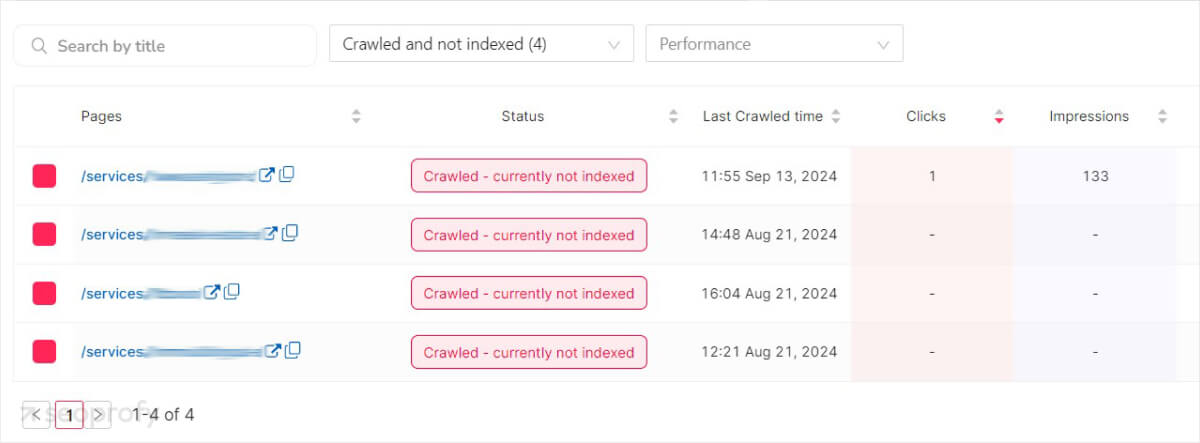
We use the Seocrawl tool to automatically track the indexing of each page and identify crawling issues, but GSC will be just as helpful. To find out why your pages are not being crawled, just click on the Pages section in GSC.
Here’s what you can find out about your pages through Seocrawl:
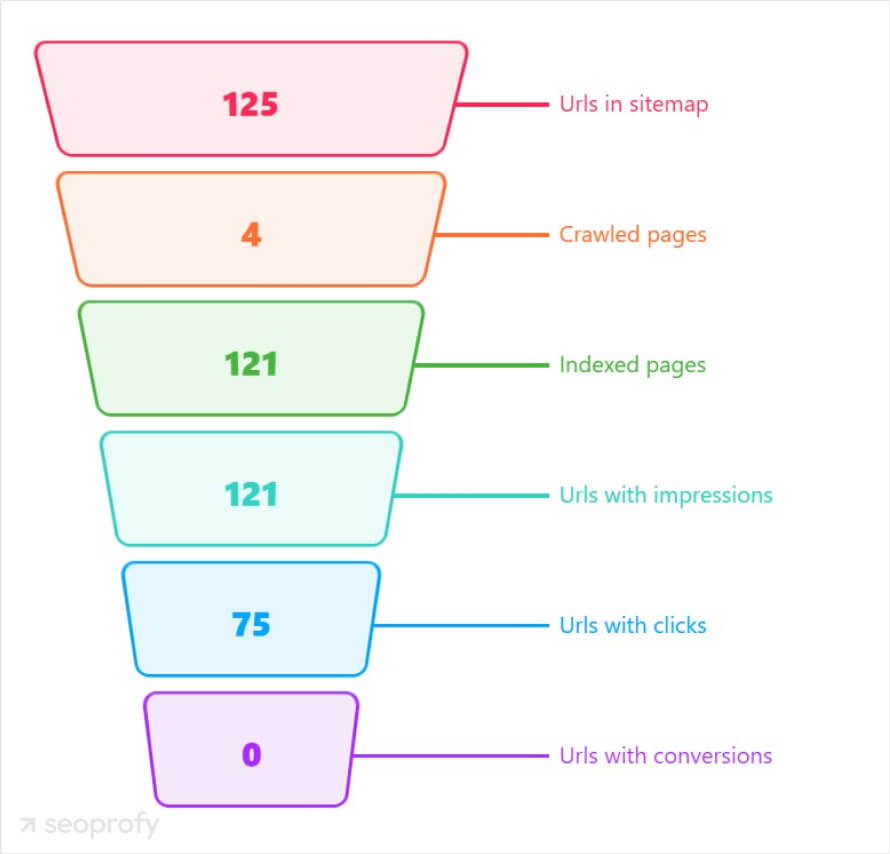
Website Redesigns or Structural Changes
One of the reasons behind a sudden drop in traffic can be poor website migration or redesign. A poorly managed redesign can ruin your site’s carefully curated SEO strategy. Imagine you’re giving your site a fresh coat of paint, but instead of attracting more visitors, you notice an organic traffic drop. What’s the problem?
The truth is that redesigns often come with changes that confuse search engines. Maybe your URL structure has shifted, you’ve added more complex navigation, or perhaps redirects were forgotten.
All of these tweaks can leave Google bots scratching their heads. The result? A decline in organic traffic and a drop in search rankings. To avoid a decline in website visitors, consider these steps before your redesign:
- Audit current SEO performance: Know what’s working and what’s not.
- Plan redirects: Ensure old URLs point to the right new pages.
- Optimize site speed and mobile usability: Don’t let these slip during the redesign.
If you’re already in the thick of a traffic drop after a redesign, it’s time to get analytical. Dive into GSC to check for crawl errors, broken links, or missed redirects. This will help you pinpoint website traffic loss causes and get back on track quickly.
Additionally, check if the mobile version of your website features the same content as the desktop. Inconsistency, missing elements, or poor mobile optimization can affect your rankings negatively. Google uses the mobile version of your website for indexing and ranking. This is known as mobile-first indexing. Ensure your mobile website is properly optimized for speed, usability, and content parity.
Site migration, whether you’re changing platforms, web hosting, or your domain name, can also make or break your site’s SEO. The entire transfer requires a lot of planning and testing, and while you can always do it yourself, we think you’d be doing yourself a favor by using professional SEO migration services to reduce the risk of errors and technical SEO problems.
Loss of Quality Backlinks
Losing valuable backlinks is one of the biggest reasons for drop in organic search traffic. This loss may signal to search engines that you’re no longer as authoritative, demoting your pages in rankings. You can track changes through Ahrefs backlink calendar.

Ahrefs allows you to keep an eye on both new and lost referring domains. It will help you understand your website’s link building performance over time.
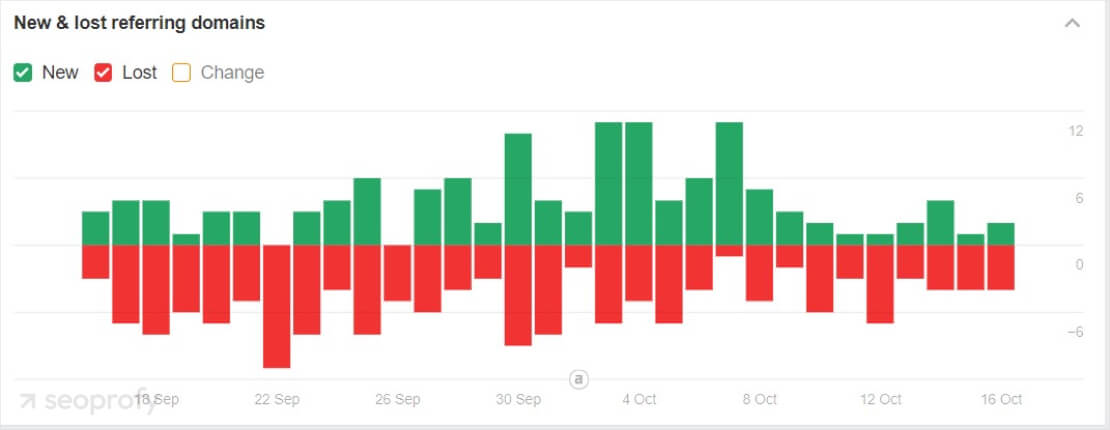
Nothing stays static on the web. Websites linking to you may have removed the page, shut down, or updated their content, dropping your link in the process.
- Audit lost backlinks: Use tools like Ahrefs or SEMrush to track lost links.
- Reach out: Politely ask the website owners to reinstate the link or offer updated content they might want to link to.
- Rebuild: Focus on creating new content and partnerships to gain fresh, high-quality backlinks.
Competitor Activity
Sometimes your Google ranking drops simply due to the competition. Competitors that produce better content, secure more backlinks, or optimize for newer keywords can easily overtake your rankings in search results. A new competitor entering your niche can also siphon away some of your traffic, even if they aren’t directly targeting your keywords.
Thorough competitor analysis is essential here. Check the top-ranking competitors that target the same primary keywords as you are. Review their backlink profiles and content to see where they may have an edge. You can do that with Ahrefs or SEMrush. Try to identify areas where they outperform you and adjust your strategy.
Changes in SERP
One major reason for a sudden shakeup in your rankings could be changes in the Search Engine Results Pages (SERPs). Google frequently updates its layout, and the introduction of new elements like Google Shopping ads or Reddit/forum links can push organic listings further down the page.
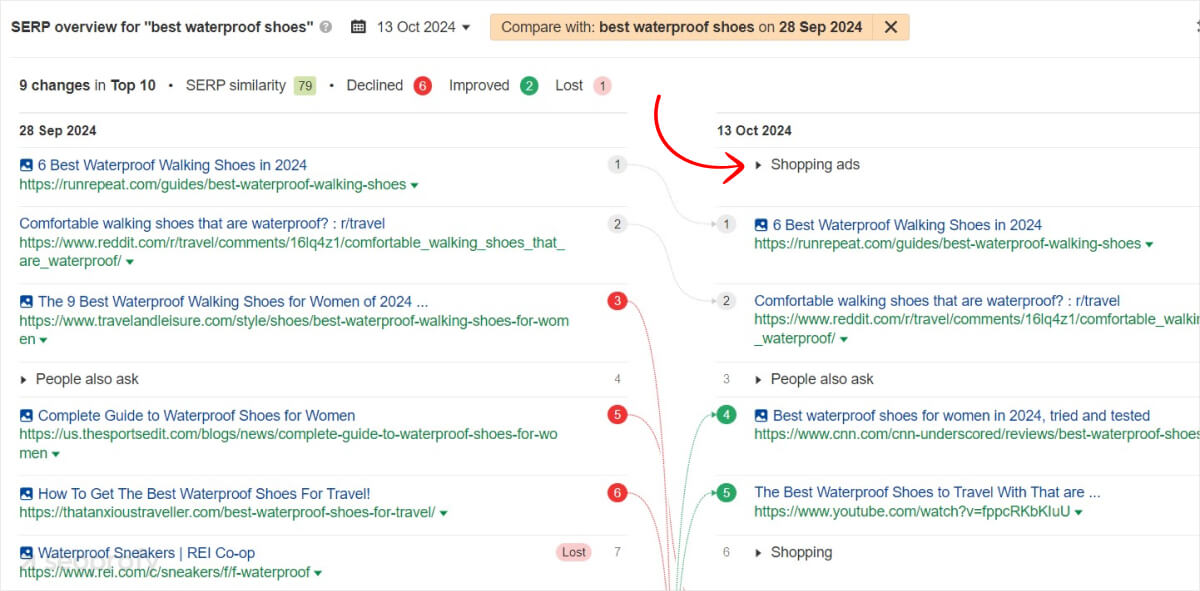
The ads, often featured prominently at the top, attract more clicks, leaving fewer opportunities for your organic results to shine. This shift in visibility can lead to a significant drop in your organic traffic, especially if your products or services overlap with what’s being promoted through these ads.
How to Diagnose the Cause of Organic Traffic Decline
Finding out the root cause of the sudden traffic drop is the most important step in recovering your lost traffic. Whether it’s an issue with your tracking code, a penalty from Google, or a drop due to inbound links, a thorough organic traffic decline analysis will help you determine the exact cause.
Google Search Console
The first step to improve organic traffic after drop involves opening Google Search Console, your best bet for figuring out what went wrong. Dive into the Performance report to see where your traffic has dipped. You can spot which keywords you’ve lost rankings for and which pages are seeing fewer clicks. It’s your window into how Google views your site.
If Google has penalized your site for violating its guidelines—whether that’s due to duplicate content, manipulative links, or other spammy practices—you may find a notification in the Manual Actions section. In such cases, you can just fix the issue and then submit a request for Google to review your site.
Google Analytics
Google Analytics is one of the best tools to identify drops in organic search traffic. Start by breaking down the traffic by segments. Maybe it’s just mobile users or visitors from specific regions that are dropping.
You can also check if the drop affects new users or returning visitors. If new visitors are down but returning ones are steady, you might have a visibility issue in search results, or your SEO might not be reaching fresh audiences.
Next, look at your bounce rate and session duration. If people are bouncing off your site quickly, something is off—either the content isn’t what they expected, or your site isn’t loading fast enough. And speaking of speed, site performance is huge.
Use Google Analytics to see if your page load times have slowed. Your recent updates or additions of plugins might be the culprit.
Third-Party SEO Tools
While GSC and Google Analytics give you a wealth of information, third-party SEO tools like Ahrefs, SEMrush, and Moz offer deeper insights into what might be happening with your rankings. These tools are particularly useful for backlink analysis.
These SEO tools can also monitor changes in your competitors’ performance. Sometimes a significant drop in traffic is not because of something you did, but because competitors are outranking you with better content or more effective SEO strategies.
Tracking Code Issues
Website owners frequently overlook tracking code issues that misreport traffic, making the decline seem worse than it really is. As a website owner, you should verify that the tracking code is properly installed across all web pages.
A missing or incorrectly installed tracking code could cause gaps in your traffic data, leading you to believe that there’s a drop when, in reality, the analytics reporting is simply incomplete. Even analytics plug-ins can sometimes malfunction after an update, affecting the data.
Google Trends
Google Trends helps you see if interest in certain keywords or topics has declined, which could explain the traffic loss. If a key term you’ve been ranking for suddenly drops in popularity, fewer people will search for it, resulting in less traffic. Use it to analyze drops in website traffic, seasonal changes, or rising topics that could be causing your traffic to fluctuate.
If you offer something seasonal or the popularity of a specific trend has gone down, you will see a change in traffic. When looking at the Google Trends data for “hiking boots,” for example, we see a gradual increase starting in September, with interest rising through the fall.
Hiking is popular in the US, and as the weather cools down, people start gearing up for outdoor activities. As for the spike in the October-November period, it is commonly connected with the start of seasonal sales and discounts. Keep an eye on this difference in popularity and demand to always stay ahead of the curve.
Best Practices to Recover Your Organic Traffic
So, now that you know why you experienced a Google search traffic drop, how do you fix it? Here are some of the most effective strategies for recovering lost organic traffic.
Focus on Your On-Page SEO
On-page SEO refers to everything you can control on your site, not just SEO performance. These can range from content quality, and keyword optimization all the way to the meta tags. If your organic traffic has dropped suddenly, reviewing and optimizing your on-page SEO is a good place to start.
The one thing you have to keep an eye on is quality and being updated. Sometimes, it means updating your content every 30 days or even more frequently, depending on the industry.
Solve Technical SEO Problems
If your site is slow, difficult to navigate, or riddled with errors, Google is less likely to rank it highly with its algorithm updates. A slow or unoptimized website is also unlikely to give users a good experience, making them more likely to bounce away than recommend your content.
Update Outdated Content
If you’re asking yourself, “why is my organic traffic decreasing,” content that’s no longer relevant or simply old news might be the culprit. Search engines favor up-to-date, relevant information, and if your pages are lagging behind the latest trends or best practices, your rankings can take a hit.
- Refresh old blog posts: Add new data, insights, or case studies to keep your content relevant.
- Revise keywords: Make sure the keywords in your content are still driving searches.
- Fix internal links: Ensure all links within the content still work and are helpful.
Build High-Quality Backlinks
When you build quality backlinks, you’re basically telling Google that your site is authoritative and trustworthy. Not to mention higher backlinks also lead to a better experience for your audience, making your site more resilient against a sudden drop in organic traffic.
Experienced an organic traffic drop after update despite quality backlinks? Well, it could be due to a loss of important backlinks or the presence of low-quality, toxic links. Avoid purchasing backlinks or engaging in black hat link building practices, as these can lead to penalties.
Monitor Competitor Activity and SERP Changes
Sometimes, the decline in website visitors isn’t because of anything you did wrong—it’s because your competitors are doing something right. If a competitor ramps up their SEO game, they might steal the top spot from you, resulting in a drop in your traffic.
- Track keyword rankings: Use tools to see how your competitors rank for shared keywords.
- Analyze their backlinks: See if they’re gaining valuable backlinks from authoritative sources.
- Study their content strategy: Are they publishing more frequently or producing higher-quality content?
Also, keep an eye on SERP changes. Google regularly rolls out new features like featured snippets or image carousels, which can push your site down in the rankings, even if your SEO plan seems perfect.
Adjusting Your SEO Strategy for Algorithm Changes
Google’s frequent algorithm updates are a common reason behind a sudden organic traffic loss. If you’re noticing a dip in traffic after one of these updates, it’s important to analyze and adjust what the update targeted—be it backlinks, mobile experience, or content quality.
- Stay informed: Regularly read SEO news and updates about Google’s algorithm changes.
- Audit affected pages: Use Google Search Console to see which pages were hit hardest by the update.
- Refine your approach: If the update focuses on mobile-friendliness, for example, ensure your site is fully optimized for mobile users.
Algorithm changes may seem like a nuisance, but they also present an opportunity. They’re Google’s way of pushing the web to higher standards, and if you adapt swiftly and prepare organic traffic decrease solutions as a pre-emptive action, you can stay competitive.
Recovering lost organic traffic means not waiting for an algorithm change to adjust your strategy. Work with a professional SEO agency to make sure your site is not only optimized but also resistant to being negatively affected by search engine updates.
Recovering Lost Organic Traffic Doesn’t Have to Be Hard
A sudden drop in organic traffic can be caused by Google, changes in user behavior, or a more complex technical issue. Finding the root cause is the first step in recovering lost traffic or views.
Struggling to figure out why your rankings tanked? Let SeoProfy handle it with a thorough SEO audit. We’ve brought countless sites back from traffic slumps. We’ll pinpoint the exact issues, craft a tailored action plan, and help you reclaim your rankings and drive traffic. Book a consultation with us today.

